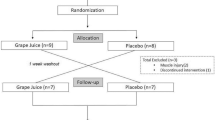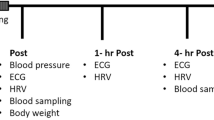Abstract
Objective
The homocysteine level is considered an important cardiocerebral risk factor. Our aim was to investigate the impact of endurance training on the homocysteine cycle in élite and non-élite athletes.
Methods
The level of physical activity was measured using a SenseWear armband in five healthy marathon runners. Two blood samples, the first under basal conditions and the second after running a half marathon, were obtained in all subjects by venepuncture. Biochemical parameters, including total homocysteine levels, were assessed.
Results
Armband data indicated that each athlete ran the half marathon keeping a race pace close to their anaerobic threshold speed. Although the run times were very different between élite and non-élite athletes, a statistically significant increase in plasma homocysteine levels (p=0.026) was observed in all runners.
Conclusion
Endurance training for 75–100 min held at a race pace close to the anaerobic threshold speed induces an increase in serum plasma homocysteine level.
Similar content being viewed by others

References
Czajkowska A, Lutosławska G, Mazurek K (2008) The relationship between physical activity and plasma homocysteine level in young men (in Polish). Pediatr Endocrinol Diabetes Metab 14(3):177–180
Tawakol A, Forgione MA, Stuehlinger M (2002) Homocysteine impairs coronary microvascular dilator function in humans. J Am Coll Cardiol 40:1051–1058
Donahue RP, Orchard TJ (1992) Diabetes mellitus and macrovascular complications. An epidemiological perspective. Diabetes Care 15:1141–1159
Russo T, Cucinotta D (2003) Iperomocisteinemia e rischio cardiovascolare nel diabete mellito. Ann Ist Super Sanità 39(2):153–163
Boushey CJ, Beresford SA, Omenn GS, Motulsky AG (1995) A quantitative assessment of plasma homocysteine as a risk factor for vascular disease. Probable benefits of increasing folic acid intakes. JAMA 274:1049–1057
Nygard O, Nordrehaug JE, Refsum H (1997) Plasma homocysteine levels and mortality in patients with coronary artery disease. N Engl J Med 337:230–236
Stampfer MJ, Malinow RM, Willett WC (1992) A prospective study of plasma homocysteine and risk of myocardial infarction in US physicians. JAMA 268:877–881
Welch GN, Loscalzo J: (1998) Homocysteine and atherothrombosis. New Engl J Med 338:1042–1050
Buysschaert M, Preumont V, Hermans MP (2007) Hyperhomocysteinemia and diabetic macroangiopathy: guilty or innocent bystander? A literature review of the current dilemma. Diabetes & Metabolic Syndrome: Clinical Research & Reviews 1(1):53–59
Cuomo V, Sacco M, Perna AF et al (2001) Elevazione della concentrazioni plasmatiche di omocisteina in pazienti con diabete di tipo I e complicanze microvascolari. GIDM 21:9–15
Garcin JM, Cremades S, Garcia-Hejl C et aI (2006) Hyperhomocysteinemia: an additional risk factor of the metabolic syndrome? Metab Syndr Relat Disord 4(3):185–195
Terruzzi I, Senesi P, Fermo I et al (2007) Are genetic variants of the methyl group metabolism enzymes risk factors predisposing to obesity? J Endocrinol Invest 30(9):747–753
Gaume V, Mougin F, Figard H et al (2005) Physical training decreases total plasma homocysteine and cystine in middle-aged subjects. Ann Nutr Metab 49(2):125–131
Vincent KR, Braith RW, Bottiglieri T et al (2003) Homocysteine and lipoprotein levels following resistance training in older adults. Prev Cardiol 6(4):197–203
Vincent HK, Bourguignon C, Vincent KR (2006) Resistance training lowers exercise-induced oxidative stress and homocysteine levels in overweight and obese older adults. Obesity 14(11): 1921–1930
Borrione P, Pigozzi F, Massazza G et al (2007) Hyperhomocysteinemia in inter elite athletes: a longitudinal study. J Endocrinol invest 30(5):367–375
Okura T, Rankinen T, Gagnon J et al (2006) Effect of regular exercise on homocysteine concentrations: the HERITAGE family study. Eur J Appl Physiol 98:394–401
Herrmann M, Wilkinson J, Schorr H et al (2003) Comparison of the influence of volume-oriented training and high-intensity interval training on serum homocysteine and its cofactors in young, healthy swimmers. Clin Chem Lab Med 41(11):1525–1531
Herrmann M, Schorr H, Obeid R et al (2003) Homocysteine increases during endurance exercise. Clin Chem Lab Med 41(11): 1518–1524
Real JT, Merchante A, Gómez JL et al (2005) Effects of marathon running on plasma total homocysteine concentrations. Nutr Metab Cardiovasc Dis 15:134–139
König D, Bissé E, Deibert P et al (2003) Influence of training volume and acute physical exercise on the homocysteine levels in endurancetrained men: interactions with plasma folate and vitamin B12. Ann Nutr Metab 47:114–118
Randeva HS, Lewandowski KC, Drzewoski J et al (2002) Exercise decreases plasma total homocysteine in overweight young women with polycystic ovary syndrome. J Clin Endocrinol Metab 87:4496–4501
Borrione P, Rizzo M, Spaccamiglio A et al (2008) Sport-related hyperhomocysteinaemia: a putative marker of muscular demand to be noted for cardiovascular risk. Br J Sports Med 42(11): 594–600
Arvidsson D, Slinde F, Larsson S (2007) Energy cost of physical activities in children: validation of SenseWear Armband. Med Sci Sports Exerc 39(11):2076–2084
Arcelli E (1998) Il nuovo correre è bello. Sperling & Kupfer, Milan
Matthews DR, Hosker JP, Rudenski AS et al (1985) Homeostasis model assessment: insulin resistance and β-cell function from fasting plasma glucose and insulin concentrations in man. Diabetologia 28:412–419
Perseghin G, Price TB, Petersen KF et al (1996) Increased glucose transport-phosphorylation and muscle glycogen synthesis after exercise training in insulin-resistant subjects. N Engl J Med 335(18):1357–1362
Author information
Authors and Affiliations
Corresponding author
Rights and permissions
About this article
Cite this article
Benedini, S., Caimi, A., Alberti, G. et al. Increase in homocysteine levels after a half-marathon running: a detrimental metabolic effect of sport?. Sport Sci Health 6, 35–41 (2010). https://doi.org/10.1007/s11332-010-0094-6
Received:
Accepted:
Published:
Issue Date:
DOI: https://doi.org/10.1007/s11332-010-0094-6



